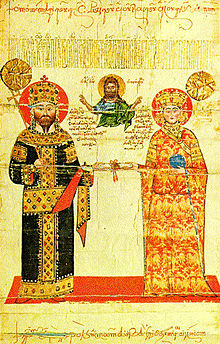Chrysobullos logos
A Chrysobullos logos (Χρυσόβουλλος λόγος) is a form of the Byzantine imperial charter with a gold bull , which was used to confer privileges. The oldest example still preserved in the original dates from the year 1052 and is in the archive of the Great Lavra on Mount Athos . However, the type of document is likely to have originated as early as the end of the 9th century. The documents were written on sheets of paper that were glued together so that rolls of considerable length could be created: 1057 3.47 m, 1060 7 m. Both privileges were also intended for the Lavra monastery.
The protocol consisted of Invocatio , Intitulatio , Inscriptio , the text contained Arenga ( Prooimion ), Narratio , Dispositio and Sanctio , the eschatokoll includes dating, Legimus and the handwritten imperial signature in red ink. Since the 13th century the protocol has been reduced to a symbolic invocatio in the form of a cross, the sanctio is omitted and the arenga is often missing. Legimus is omitted in the eschat protocol and the date is combined with a handover note. Since the 14th century, the bombyzin paper has usually been replaced by parchment.
Towards the end of the 11th century, the Chrysobullon Sigillion was introduced as a simplified form for privileges of lesser importance . The Chrysobullos Horismos has been even more simplified since the 14th century , which differs from a prostagma through the imperial signature, which is replaced by the menologeme in the prostagma , and the gold bull . The designation chrysobulls is often used for the documents sealed with gold bulls .
literature
- Franz Dölger : Regest of the imperial documents of the Eastern Roman Empire from 565-1453. Volume 2: Regesta from 1025–1204 (= corpus of Greek documents of the Middle Ages and modern times. Series A, Section 1, 2). Beck, Munich 1925.
- Franz Dölger, Johannes Karayannopulos : The Imperial Documents (= Handbook of Classical Studies. Department 12: Byzantine Handbook. Part 3, Volume 1: Byzantine Doctrine of Documents. Section 1). Beck, Munich 1968, pp. 117-128.
- Werner Seibt : Chrysobull. In: Lexicon of the Middle Ages . Volume 2: Beggars to the Codex of Valencia. Metzler, Stuttgart 1999, ISBN 3-476-01742-7 , Sp. 2050
Individual evidence
- ^ Dölger: Regest of the imperial documents of the Eastern Roman Empire from 565-1453. Volume 2. 1925, No. 907.
- ^ Dölger: Regest of the imperial documents of the Eastern Roman Empire from 565-1453. Volume 2. 1925, No. 932.
- ^ Dölger: Regest of the imperial documents of the Eastern Roman Empire from 565-1453. Volume 2. 1925, No. 946
